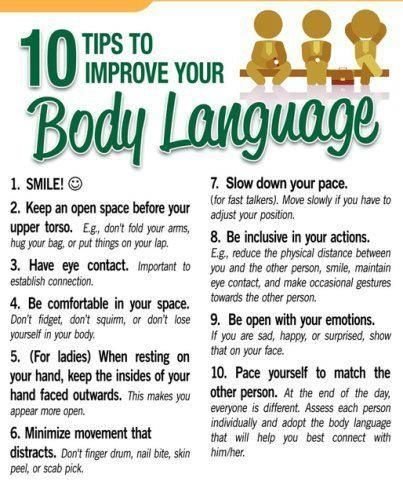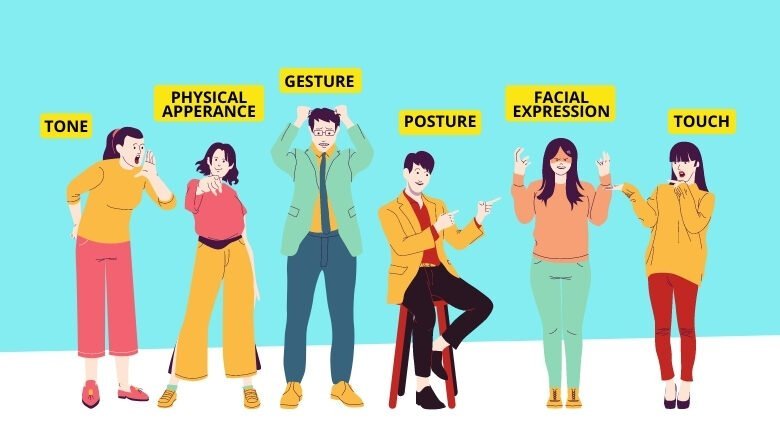BODY LANGUAGE | 10 TIPS ON HOW TO USE BODY LANGUAGE TO YOUR ADVANTAGE
BODY LANGUAGE | 10 TIPS ON HOW TO USE BODY LANGUAGE TO YOUR ADVANTAGE. BODY LANGUAGE- Definition: “Body language is the unconscious and conscious transmission and interpretation of feelings, attitudes, and moods, through body posture, movement, physical state, position, and relationship to other bodies, objects and surroundings, facial expression and eye movement, the process of communicating what you are feeling or thinking by the way you place and move your body rather than by words”.

The study of body language is known as kinesics, which is derived from the Greek word kinesis, meaning motion.
Importance of Body Language:
- When one expresses his/her feelings, it has been said that.
- 55% of the communication consists of body language.
- 38% is expressed via the tone of voice or intonation and amazingly only 7% is communicated via words.
- This means that we express most of our feeling (93%) in a non-verbal way and our words only convey 7% of what we are saying or expressing.
- Body Language is a significant aspect of modern communications and relationships.
- Body Language is therefore very relevant to management and leadership, and to all aspects of work and business where communications can be seen and physically observed among people.
- Body language is also very relevant to relationships outside of work, for example, in families and parenting, behaving with friends, etc Communication includes listening.
- In terms of observable body language, non-verbal (nonspoken) signals are being exchanged whether these signals are accompanied by spoken words or not.

Factors of Body Language:
- Body language is not just about how we hold and move our bodies.
- Body language potentially (although not always, depending on the definition you choose to apply) encompasses:
- how we position our bodies,
- our closeness to and the space between us and other people and how this changes,
- our facial expressions,
- our eyes especially and how our eyes move and focus, etc,
- how we touch ourselves and others,
- how our bodies connect with other non-bodily things, for instance, pens, cigarettes, spectacles, and clothing,
- our breathing, and other less noticeable physical effects, for example, our heartbeat and perspiration.
Body language tends not to include the pace, pitch, and intonation, volume, variation, pauses, etc., of our voice.
- Voice type and other audible signals are typically not included in body language because they are audible ‘verbal’ signals rather than physical visual ones, nevertheless, the way the voice is used is a very significant (usually unconscious) aspect of communication, aside from the bare words themselves.
- Similarly, breathing and heartbeat, etc., are typically excluded from many general descriptions of body language but are certainly part of the range of non-verbal bodily actions and signals which contribute to body language in its fullest sense.
More obviously, our eyes are a vital aspect of our body language.
- Our reactions to other people’s eyes – movement, focus, expression, etc – and their reactions to our eyes -contribute greatly to mutual assessment and understanding, consciously and unconsciously.
- Our interpretation of body language, notably eyes and facial expressions, is instinctive, and with a little thought and knowledge, we can significantly increase our conscious awareness of these signals: both the signals we transmit, and the signals in others that we observe.
- Doing so gives us a significant advantage in life – professionally and personally – in our dealings with others.
- Body language is not just reading the signals in other people.

PROBLEM-SOLVING:
- Problem Solving is a mental process wherein an individual analyzes interpret a task or a problem at hand and chooses from a pool of possibilities to reach the simplest solution.
- It involves an individual’s creativity and decision-making abilities.
Following steps should be followed while solving a problem:
1. Identifying the problem:
- It is important to have clarity about what the problem at hand is and what it demands.
- The resources required to solve the task and the kind of solutions that have been used before and have been successes and failures.
2. Forming a strategy:
- The approach to solving the problem will depend upon the environment and the available resources. It will differ from individual to individual since they will have their preferences and set schemas.
3. Organizing Information:
- As stated before, it is important to gather as much information as possible and organize it, segregating it to identify the gaps.
- Whether it’s a top-down approach or a bottom-up approach, one should be able to identify the source of the problem.
4. Allocating resources and monitoring the process:
- Once you know the problem, its source and have organized the information, allocate the resources such as time, money, etc, including past experiences and future impacts.
- For effective solutions, one also needs to monitor the progress of the approach to avoid being caught in the vicious circle of escalation of commitment.
5. Evaluating the Solution:
- Once the task at hand has been solved, what are its present and future impact?
- It can be immediate such as solving a math problem or a long-term process such as a learning curve.

10 Tips on How to Use Body Language to Your Advantage
- Now that you have learned such a lot about body language, let us look at a few points that would help advance in life.
- Here are a few simple yet very powerful tips that would help get ahead of the competition.
1. Show That You Are In Control
- Before you enter a room where you want to make the right impact, or before you meet a person you need to impress take a long and deep breath.
- When you do this, the muscles of your jaw, neck, and shoulder would relax giving you a natural posture – instead of a rigid and false one.
- The natural look would have you received better than an aggressive look that would have been perceived had you walked in with a rigid neck and
shoulder muscles (rigid because you were anxious).
2. Move and Speak For Best Impact
- Human beings are instinctively drawn to movement.
- When you move, the eyes instantly become focused on you – and with the eyes of your brain.
- Hence, to attract attention and hold it, move while you speak or make a presentation.
- To ensure maximum attention move for a slight while and stand still and deliver the statement you want.
3. Rotating Your Palms Downward To Confirm Authority
- People read the palms down sign as an authority.
- Hence, when you want people to listen to you and take you as a decisive and no-nonsense person, all you have to do is use gestures that get your palms to rotate downwards.
- This is especially important if you feel very strongly about anything and want to make a big deal out of it.
4. Want To Be Respected For Your Opinion at Meetings, Speak First
- At meetings or in discussion groups the person who talks early is remembered as important and assertive.
- This is because, in the beginning, most people feel they need time to warm up before giving their opinion and hence, admire those who speak early are looked up as leaders in a minor way.
5. Gauge the Readiness of Your Audience
- If the person is interested in what you have to say, he would sink back into the chair and assume a relaxed stance, i.e. he is ready to listen to you patiently.
- If the person is not interested, he would get himself poised to get up and go.
- If this happens, you should either wrap up what you have to say quickly or change the topic and see whether you can capture the person’s or the audience’s attention and interest.
6. Know Whether It’s A Good or Bad Time to Negotiate
- Before you launch into negotiations, it would be good if you test the water a little.
- It is always best to negotiate when the time is ripe to get the best outcome.
- To find out whether that is a good time or not test the rapport you have established with the others using body language.
Let us say you are seated at a conference table.
- Facing one of the people (or more), suddenly lean away from him pushing your seatback.
- In most cases, you will find that the other person too would more or less mirror your actions.
- This is how you alienate a person.
- To bring him back to the connect, all you have to do is lean towards the person now and ensure that hands are visible with one or both palms facing upwards.
- Look at him, and flash a genuine smile.
- It would very rare that you would not get an instant friendly reaction from the other person.
- If you can sway the person in this manner – it is the best time to talk about whatever you want to negotiate.
- It is most likely that you would win.
7. To Make an Impact and Get Them
- Listen Widen Your Stance We have spoken in the earlier chapters about how important stance is.
- When you want to make a statement that everyone should listen and obey, widen your stance, take a deep breath and keep both feet firmly on the ground feel the breath in and out and the calmness and centering it brings you.
- When you are relaxed and use this stance the voice would come out more resonant and deeper.
- A confident stance and deep voice are the recipes for the highest level of persuasion ability.
- When you master this type of stance, few would be able to resist your charm.
8. To Get Back Into the Saddle, Take a Step Back – Literally
- There would be times when you find that you have lost all control.
- When you want to get back the reigns in whatever crowd you are in, all you need to do is take a few steps back.
- That is about all – and it is an excellent tip.
- Try it anywhere and see the other person’s reaction instantly.
9. To Give the Impression of Trust, a Cup of Coffee Will Help
- Trust is the basic ingredient in any type of relationship – without establishing trust you would not be able to proceed with negotiations.
- To show you are trusting, you need to have a cup of coffee at chest level. Surprisingly, when you do so, more often than not people will warm up to you, and bam! You have them eating out of your hand.
10. Shake Hands Before And After
- People who shake hands as soon as they meet are more likely to get the deal inside the bag.
- It is easy to remember this tip.
- Offer to shake hands before and shake hands again at the end of the deal.
- Studies show that people who have taken the trouble to shake hands before negotiations, have better chances to close the deal.
- This is because there is a higher degree of trust and better rapport between the two persons.
- SELF ESTEEM: HIGH OR POSITIVE SELF ESTEEM V/S LOW SELF ESTEEM
- A Manifestation Is A Tool For Personal Growth
- WHAT IS MOTIVATION?
- https://youtu.be/1sfM-xx7tHI
- https://youtu.be/ZK3jSXYBNak
- https://youtu.be/Yv7e6_8SSo8
- 20+ सर्वश्रेष्ठ ऑनलाइन लर्निंग प्लेटफॉर्म | सर्वश्रेष्ठ ऑनलाइन लर्निंग प्लेटफॉर्म कैसे चुनें? | 20 Best Online Learning Platform 2022




